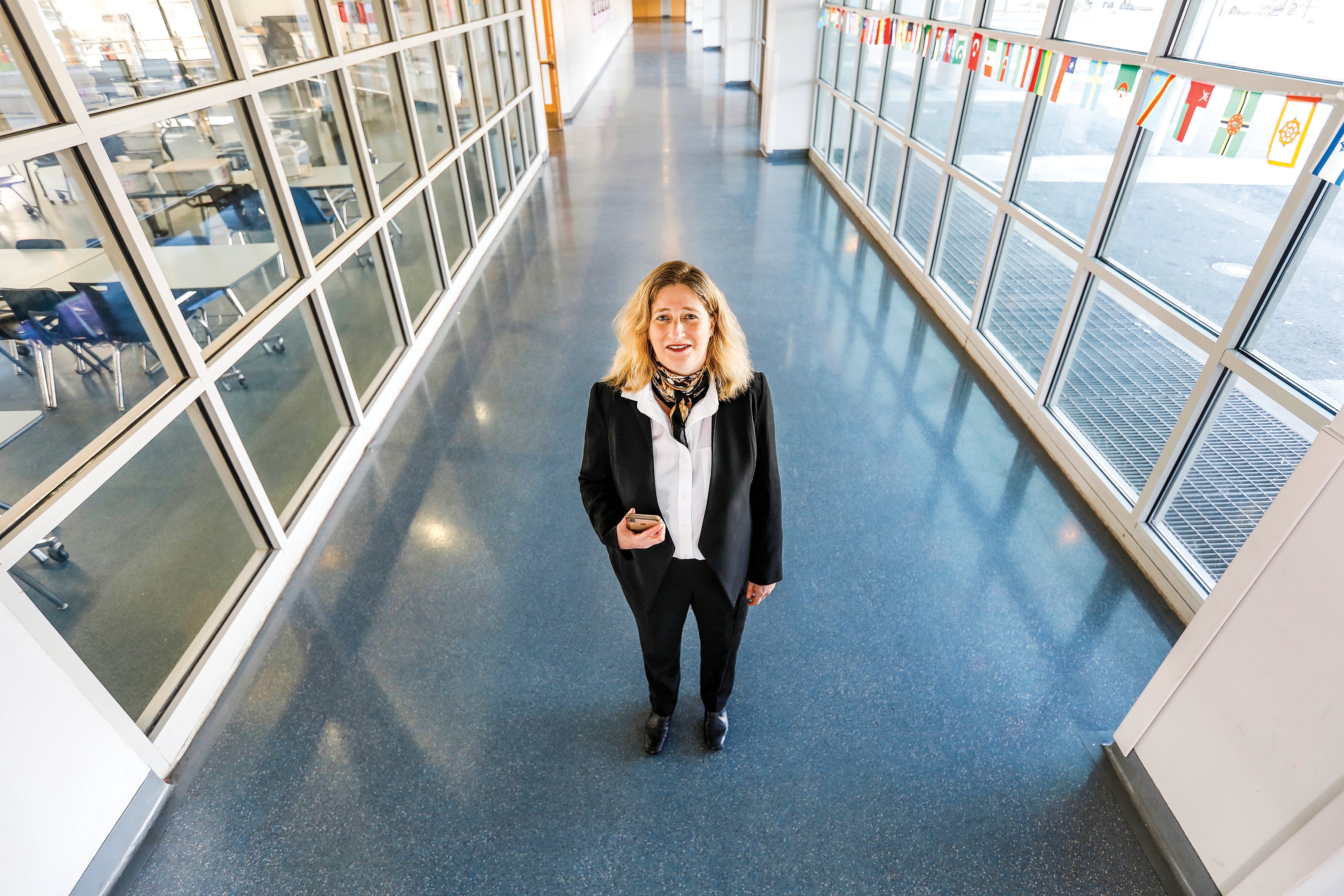A 13-year-old girl sits in the backseat of the family car snapping selfie after selfie. She’s in constant motion, trying on pouts and smiles, tilting her phone high and low, whipping her hair in all directions.
Her dad finds the whole thing pretty funny, so he records it on his phone and posts the video to Facebook and YouTube. Soon it’s spread across the internet, racking up millions of views and hundreds of comments. Eventually, it even plays on Good Morning America.
In all that sharing, was the daughter’s privacy violated? And do we have an obligation to ask people before we spread their image around the internet?
According to a class of fifth-graders at the Montclair Cooperative School in Montclair, New Jersey, the answer to both questions is a strong “yes.”
Montclair Cooperative is among a handful of local elementary and middle schools that are welcoming fellows from the Institute for Privacy Protection at Seton Hall’s School of Law into their classrooms to teach students about smartphone privacy, reputation management and digital advertising, as well as how
to find a healthy online/offline balance.
Fifth grade may sound a little young for all that, but according to a 2016 Nielsen report, almost half of U.S. children ages 10 to 12 already have their own smartphones. Namita Tolia, Montclair Cooperative’s Head of School, estimates that the percentage may even be a little higher among her fifth-graders.
As they play games or watch videos on those phones, kids are often surrendering their personal information and staring at targeted ads. Or they’re posting stuff — photos, videos, tweets — that could haunt them later. (Just follow the stream of news stories about teens whose college acceptances were rescinded or lives otherwise imploded because of a single social media post.)
Parents and teachers know how serious the stakes are, they know how pivotal this moment is, but they’re still struggling with how to protect kids from the amorphous threat of the internet.
“This isn’t multiplication or something we’ve already figured out how to teach,” Tolia says. “This is a new area, and we’re all searching for ways to convey it effectively.”
That’s where Seton Hall Law comes in.
For Kids — and Their Parents
Andrea Blumenthal’s 10-year-old son, Max, usually doesn’t say much about his day at school.
“He’s not a big reporter,” Andrea says. “So unless I ask the perfect question, I don’t really get a full picture of things.”
But on the first day that a Seton Hall Law fellow came into his fifth-grade classroom at Montclair Cooperative, Max couldn’t wait to tell his mom about it.
“He came home and he was very excited,” Andrea remembers. “‘Mom, we took this really fun class.’ He was intrigued and thought it was really useful.”
The Institute for Privacy Protection has now brought its outreach program to six schools in North Jersey and Manhattan. Armed with a curriculum designed at Seton Hall Law, fellows lead four classroom sessions, and the institute’s director, Gaia Bernstein, wraps things up with a lecture for parents.
“I have kids myself, and I see lots of parents with kids,” Bernstein says. “I saw how desperate they were and I saw the opportunity to reach both parents and children at the same time. If we do that, hopefully we can start a conversation — because I think this model of the parent police person trying to stop kids from using technology is not really working.”
The Seton Hall program doesn’t cover cyberbullying or the dangers of meeting strangers on the internet — two worthy but well-tread topics. Instead, its lessons revolve around less-examined online issues like digital footprint, targeted advertising and information-gathering.
In one exercise, students have their personal information — not just name, phone number and address, but also dog’s name, dad’s job, and an embarrassing story — taped to their backs. “The kids got creeped out right away,” Tolia remembers. “I can’t see what’s on my back, but all these people know this information about me.”
“It taught us that if we’re not careful, our personal information could go to basically everyone who has access to the internet and they could all see it,” says Andrew Mata, an 11-year-old in Max’s class at Montclair Cooperative.
Classes also touch on “sharenting” — when parents, like the selfie teen’s dad, share their kids’ photos or information online — and talk about approaching a friend to take down photos they’ve posted of you, and whether it’s OK to post pictures of your friends online without letting them have a first look.
In discussions about advertising in mobile-game apps, the fellows explain how seemingly innocuous prompts for an email address or ZIP Code are actually a form of privacy invasion and can lead kids to share more information about themselves than they realize.
Max says his favorite activity involved reading profiles of imaginary students and, pretending he was an administrator, choosing one student to represent the school. The complicating factor: each of the potential ambassadors had done something ill-advised on the internet.
“People thought it was really interesting and we talked about it a lot,” Max says. He learned that “if you put information on the internet, people might see it and not think you’re a good fit for a job.”
Tolia praises the program’s focus on experiential learning. “You can say to a child, ‘Don’t put your information on the internet,’ but they’re just going to tune you out,” she says. Instead, the Seton Hall Law curriculum “created experiences for children to come to that understanding themselves.”
The lessons also lead kids to make connections that Bernstein didn’t even consider when she was developing the program. Shane Mata says his son, Andrew, has more carefully considered how his privacy might be at risk while gaming online ever since a Seton Hall Law fellow came to his classroom.
In the popular multiplayer shooter game Fortnite, kids often play with people much older than they are, and just this past fall, a 45-year-old man was arrested for allegedly threatening an 11-year-old who beat him at the game. Since absorbing the Seton Hall curriculum, Andrew says he no longer plays on Fortnite teams with people he doesn’t know in real life.
“I think when it’s something he talked about at school, it’s real, and it’s more relevant to him,” Shane says. “And the beauty of it is listening to him saying how he and his classmates started making connections: first it was [privacy around] video games, then email addresses.”
“When they first come in, they’re always very sure, ‘I don’t share anything I shouldn’t share,’” says Angela Cooper, one of the fellows. “It’s fun to see them make the connection of ‘wow, I did give personally identifiable information’ — and they make the most unique connections.”
Cooper remembers a fifth-grader with her own YouTube channel. After starting the Seton Hall curriculum, the student told Cooper she’d realized her house and street number sometimes appeared in the footage —and said she was now filming only in a designated area of the house to avoid revealing where she lives.
As a parent, “it took a lot of pressure off,” Shane says of the fellows’ lessons, “because sometimes I either don’t have the time to fully explain something or I didn’t even think of it.”
How It Began, Where It’s Going
The Institute for Privacy Protection was born thanks to junk faxes. In 2016, a federal judge awarded Seton Hall Law $1.7 million in funds left over from a class-action junk fax consumer settlement. (The individual awards in such cases are often so small that many people don’t collect them — but together those unclaimed payouts can add up to a big number.)
From its outset, the Institute aimed to educate consumers and businesses about emerging privacy issues and, as its website put it, “unsolicited invasions of their personal space through novel technologies and various forms of marketing.” Like, say, junk faxes.
Bernstein, a Seton Hall Law professor since 2004, was named the new Institute’s director. As she thought about a first project, Bernstein says she quickly landed on kids and phones. “I decided that reaching kids at this age when they get their first cellphone and parents really lose control was important,” she says. “We have this moment of opportunity when they have phones but they’re not too ingrained in their habits yet.”
After developing a curriculum with faculty fellow Najarian Peters, selecting student fellows, and piloting the program in the summer of 2017, Bernstein took it out for a full debut in the 2017-18 academic year at five schools. Today the Seton Hall fellows have gone into about 20 local classrooms and taught more than 500 kids.
Ever since The Washington Post and CBS This Morning ran stories on the program, Bernstein has been getting more requests than she can possibly meet. (The Institute selects only four fellows each year to go into classrooms, and on top of that, Bernstein and Adjunct Professor of Legal Practice Julia Hernandez are constantly updating the lessons to keep them relevant.)
“I want to spread this curriculum as far as possible, but without compromising its integrity,” Bernstein says. She’s still figuring out exactly how to do that, though. She may create some curriculum summaries, or perhaps offer more public webinars like the one she and Peters presented last summer.
Montclair Cooperative was one of the schools that got in on the program early — and with an administrator like Tolia, it’s not surprising they did. She’s a head of school who points out the misnomer of “smartphone” (you’re really carrying around a mini computer more than a phone, she says), who has banned all cellphone use during the school day, and who champions experiential learning.
When Tolia heard that Seton Hall Law was piloting a school program centered on online privacy, she eagerly volunteered as a test school. Since then, Montclair Cooperative has also welcomed fellows for the 2017-18 and 2018-19 academic years.
The experience has prompted Tolia to consider how her school can further help parents tackle online privacy issues. She’s considered weaving some of the information into a Back to School Night talk or organizing times for parents to meet up and compare their concerns and strategies.
“I’m very inspired,” Tolia says. “We’ve been largely silent on the subject, but we really need to start giving more guidance as a school about what the kids are ready for when, what the dangers and pitfalls are, and the mindfulness around everyone in the family using phones.”
“I’m appreciative that Seton Hall is taking curriculum development for young kids seriously,” she adds. “That’s unusual. This is a really pure-hearted endeavor. I could see lots of schools being inspired by the way they’re doing it.”
Molly Petrilla is a freelance writer based in New Jersey.
Too Much of a Good Thing
In addition to its school outreach efforts, the Institute for Privacy Protection also runs conferences related to privacy issues. So far, the meetings have covered regulation of privacy and social media, artificial intelligence and the law, and secure voting.
This past October, the Institute hosted a “Kids’ Technology Overuse” workshop and brought in psychologists, doctors, technologists, activists and educators from all over the world. Gaia Bernstein, director of the Institute for Privacy Protection, says she’s passionate about the idea of technology overuse — and lessons on it are woven through the School Outreach curriculum. (Students are asked to estimate how much time they spend on their phones and then actively track it.
They’re also challenged to put down their devices for a full weekend day and report back on whether they could do it and how they felt.) Right now, Bernstein is working on a book about tech overuse that she hopes to finish by the end of this year. While other books have examined the issue from a psychology perspective,
Bernstein says she’s the first legal scholar to tackle it.“Child psychologists think about this as an individual issue, but I’m thinking about it as a social problem,” she says. “For me, it’s more like cigarettes or the fight against junk food. I see this as something not necessarily within an individual’s control. And because of that, we need to have some legal interventions.







